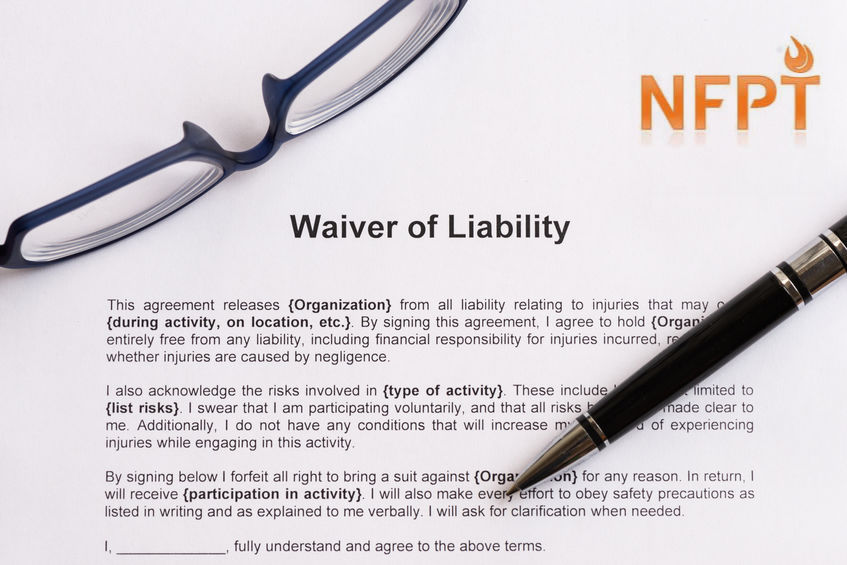No matter how great your passion for fitness is as a trainer and despite your best intentions some clients may become injured during exercise, making it imperative to have liability waivers in place from the start of your clients’ training process
In our litigious society, any misstep or injury on your watch may result in a lawsuit against you and your facility.
Many personal trainers choose to grab a basic liability waiver off the web thinking it will protect them. Unfortunately, a weak liability waiver opens you up to all sorts of trouble. Using a rock-solid personal training waiver form and understanding trainer negligence can prevent lawsuits from being successful.
Here’s how to make sure your liability waivers are legally sound and that you understand the legal implications of being a trainer.
 Liability Waivers Save The Day
Liability Waivers Save The Day
We all tend to gloss over many of the liability waivers we sign, but the following cases show how important they are!
A quick Google search reveals plenty of cases where a client sued their personal trainer and their facility for negligence. These clients claim that they weren’t made aware of risks involved in an activity and that the trainer was negligent.
Consider the case of Hinkal v. Pardoe. A woman suffered a severe neck injury while exercising under the supervision of a personal trainer and sued him and the gym. The waiver she signed included an assumption of risk clause that waived the right to sue over personal injury. She claimed she did not read it, and it was not explicitly pointed out to her. There was some back-and-forth over the location of the clause in the document – but the court upheld the legality of the waiver.
Another case, Evans v. Fitness & Sports Clubs, LLC, had a similar outcome. A 61-year old woman was doing suicide runs with a trainer when she tripped and fractured both wrists. She too claimed the risk clause was not explained to her – but her signature on the agreement was all it took for the court to rule in favor of the trainer and gym.
Hopefully, you will never end up in a situation like these, but stuff happens!. Liability waivers are put in place to protect you and the facilities you train at. Yet they are only one piece of the puzzle in making sure you protect yourself.
Risk Factors For Lawsuits
Liability waivers don’t make you litigation-proof. In the case of Corrigan v. Musclemakers Inc., the court sided with the plaintiff as it was clear the personal trainer was negligent in their duties.
Being a fitness mentor to your clients means making sure you push them to excel within reason. You should also be mindful of providing advice that might be outside your scope. These are some training risks you should be mindful of from a legal standpoint:
Trainer Qualifications
Sometimes trainers or the gyms they work in misrepresent the trainer’s qualifications. Make sure the information you provide about your certifications is accurate, and always renew your them before they expire.
Equipment Use
Equipment-related injuries are the leading cause of lawsuits against personal trainers. You should always ensure that equipment is in good working order, that free weights are used safely, and that weight or pace is increased in moderation.
When you are on the clock, you should always be supervising your client and monitoring their posture and form.
Too Hard, Too Fast
You always need to strike the right balance when pushing your client to go harder. If they are complaining of fatigue or pain, or that they want to stop, make sure you address those concerns. Your clients see you as an expert, and if you push them to the point of breaking they could very well use that as an excuse to sue. Don’t ramp up the pace or weight involved in activity until you are positive they are already comfortable at the current pace.
Supplements & Health Advice
You need to be cautious about offering any health or dietary supplement advice to your clients. This is outside the scope of your role and can result in negligence claims if the advice causes harm.
For example, there have been cases where trainers have recommended supplements to clients who then had bad reactions and sued. If you do want to recommend health or dietary advice to a client, you should always insist they consult with their physician or dietitian.
How to Ensure My Liability Waiver is Rock-Solid
When your client signs an exercise waiver and release form, they are agreeing to the terms in that document. This includes the assumption of risk and their waiving of the right to sue.
However, a liability waiver is only as good as the language used. As this is a legal contract, you need to ensure the included clauses and phrasing will be interpreted in your favor by a court of law.
Here are some liability waiver form tips from Pepper Hamilton LLP:
- Use unambiguous words in the liability waiver to make clear that the customer is agreeing to relieve the business from liability. For example, explicitly stating that clients waive the right to sue for “ordinary negligence” as opposed to “negligence” is often viewed more favorably in court. This can be strengthened further by explicitly waiving “ordinary negligence of [Business Name]” which helps strengthen claims of injury due to inherent risks in exercise.
- Incorporate language plainly stating that the customer is assuming the risk of personal injury and that the customer is waiving all claims for personal injury.
- Print the waiver in bold capital letters or some other type of conspicuous font to provide the customer with notice of its content and legal significance.
- Make the waiver part of an agreement that the customer is required to sign, rather than simply publishing the waiver on a receipt or ticket stub.
- Insert a statement above the signature line of the agreement that prompts the customer to read the entire agreement and requires the customer to acknowledge doing so.
- Require the customer to print his or her initials underneath the waiver or to make some other affirmative acknowledgment that the customer has read it.
- Include an integration clause stating that the agreement is the entire agreement between the parties, and supersedes all prior agreements, whether written or oral, with respect to such matter.
These guidelines exist to give you an idea of what goes in a waiver, but you should always consult with a lawyer to ensure your waiver is airtight.
Waiver laws vary from state to state, and the language must be specific to you and your practice. Consult with a lawyer who is familiar with waiver laws in your state and, if possible, also has a working knowledge of the fitness industry.
You should make sure your waiver is a separate document from your personal training client agreement form. A stand-alone waiver stands up much better in a court of law.
Insurance: How to Further Cover Yourself
Along with your rock-solid liability waiver, you also need to make sure you are insured. Insurance helps protect you against liability, covering the costs of injury and negligence claims. Many insurance policies also include property damage claims from the facilities you work in – and many gyms need you to have your own insurance.
You also need to keep meticulous records for your protection. An electronic waiver signing platform is a great way to keep all your waivers centralized and look up client information.
You should also make sure to keep records of the following:
Fitness Assessment and Health Screening: A workout regimen should always be tailored to the fitness level, ability, and goals of the client. This assessment should include a health screening with the client’s medical history, weight, and blood pressure. You should also set benchmarks in your program where you reassess fitness and health.
Physician Release Form: If a fitness assessment reveals that a client is a high risk for exercise, you should insist on a physician’s consent form. This will further protect you in the case that the client’s regimen leads to health complications.
Client Progress Reports: Paperwork is your friend in the court of law and also helps you track the progress of your clients. You should keep notes on each session, special instruction that is given to clients (and if that instruction was followed), and any concerns about equipment use. In the event that the client needs first aid, be sure to fill out an incident and first aid report in detail.
By keeping meticulous records and being mindful in your practice, you can look forward to a long and successful career as a personal trainer.
Justin Li is the co-founder and CEO of Aries App inc., the developer of the electronic waiver signing solution WaiverForever. He spends most of his time listening to customer feedback and defining product strategy. When he’s not working, he enjoys working in his backyard and travel with his family.

 Liability Waivers Save The Day
Liability Waivers Save The Day 


